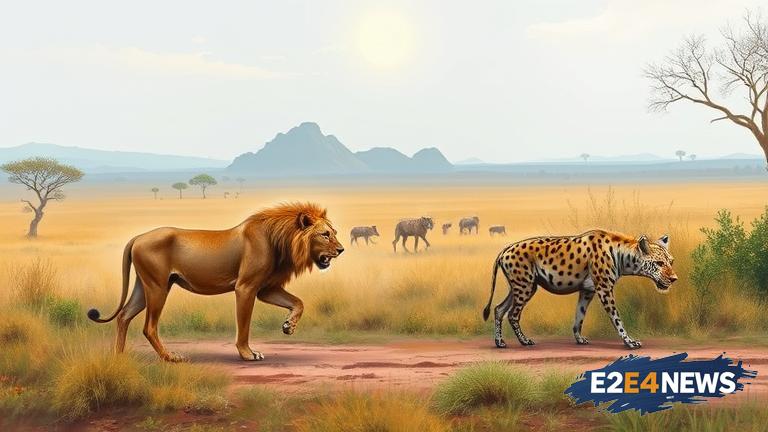Climate change is having a profound impact on the natural world, with many species being forced to adapt to new environments in order to survive. One of the most significant effects of climate change is the alteration of migration patterns, with many animals being driven out of their traditional habitats in search of food, water, and shelter. Lions and hyenas, two of the most iconic predators in the animal kingdom, are among the species being affected by these changes. As temperatures rise and ecosystems change, lions and hyenas are being forced to move to new areas in search of prey and suitable habitats. This migration is having significant implications for conservation efforts, as it is altering the delicate balance of ecosystems and potentially leading to conflicts between humans and wildlife. In Africa, where lions and hyenas are found, the changing climate is altering the distribution of prey species, making it harder for these predators to find food. As a result, lions and hyenas are being forced to move into new areas, including agricultural lands and human settlements, in search of prey. This is leading to conflicts between humans and wildlife, as lions and hyenas come into contact with people and their livestock. Conservation efforts are underway to protect lions and hyenas, including the creation of protected areas and the implementation of measures to reduce human-wildlife conflict. However, more needs to be done to address the root causes of climate change and to protect these iconic species. The migration of lions and hyenas is also having significant implications for ecosystem health, as these predators play a crucial role in maintaining the balance of nature. Without lions and hyenas, ecosystems can become degraded, leading to a loss of biodiversity and ecosystem function. Furthermore, the loss of lions and hyenas can have significant economic implications, as these species are an important part of the tourism industry in many African countries. In addition to the economic implications, the loss of lions and hyenas can also have significant cultural implications, as these species are an important part of the cultural heritage of many African communities. The migration of lions and hyenas is a complex issue, and addressing it will require a comprehensive approach that takes into account the social, economic, and environmental factors that are driving these changes. This will require the collaboration of governments, conservation organizations, and local communities, as well as a commitment to addressing the root causes of climate change. By working together, it is possible to protect lions and hyenas, and to preserve the delicate balance of ecosystems that these species inhabit. However, time is of the essence, and action must be taken quickly to address the impacts of climate change on these iconic species. The fate of lions and hyenas is in our hands, and it is up to us to take the necessary steps to protect them. The changing climate is a global issue, and it will require a global response to address the impacts on lions and hyenas. This will involve reducing greenhouse gas emissions, protecting natural habitats, and implementing measures to reduce human-wildlife conflict. By taking these steps, it is possible to protect lions and hyenas, and to preserve the natural world for future generations. The migration of lions and hyenas is a wake-up call, highlighting the urgent need for action to address the impacts of climate change on the natural world. It is a reminder that the natural world is interconnected, and that the actions of one species can have significant implications for others. The loss of lions and hyenas would be a tragedy, not just for the ecosystems they inhabit, but for the planet as a whole. It is up to us to take the necessary steps to protect these iconic species, and to preserve the delicate balance of nature.





